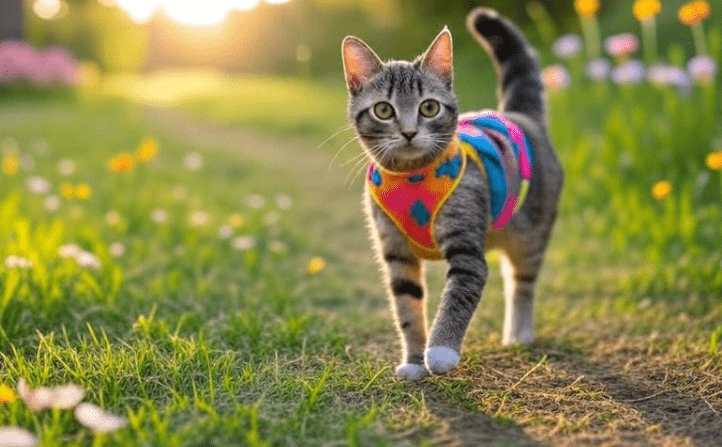
For many cat owners, the idea of letting their feline companion explore the great outdoors is both exciting and nerve-wracking. The thought of your beloved pet enjoying fresh air and natural stimulation is heartwarming, but the fear of them getting lost or injured can be overwhelming. The good news is that with the right approach, you can train your cat to go outside safely while minimizing risks.
Learning how to train a cat to go outside safely involves patience, proper preparation, and understanding your cat’s instincts. This guide will walk you through every step—from assessing your cat’s readiness to teaching essential recall commands and using safety gear like harnesses and GPS trackers. By the end, you’ll have the confidence to let your cat enjoy outdoor adventures without the constant worry of losing them.
What This Guide Covers
Training a cat to explore the outdoors isn’t as simple as opening the door and letting them roam. It requires a structured approach that prioritizes safety while allowing your feline friend to experience the world beyond your living room. This guide will cover:
Understanding if your cat is suited for outdoor adventures – Not all cats thrive outside, and some may prefer the comfort of indoor life.
Essential safety precautions – How to minimize risks from traffic, predators, and other outdoor dangers.
Harness and leash training – A step-by-step method to acclimate your cat to walking on a leash.
Creating a secure outdoor space – Alternatives like catios (cat patios) and enclosed gardens.
Recall training – Teaching your cat to come back when called.
Tracking solutions – Using GPS collars and microchips for extra security.
By following these steps, you can ensure your cat enjoys the outdoors while staying protected.
Is Your Cat Ready for the Outdoors?
Before introducing your cat to the outside world, it’s crucial to assess their personality, age, and health. Some cats are naturally more adventurous, while others may be too timid or physically unfit for outdoor exploration.

Kittens and young cats tend to adapt more quickly to outdoor training, but they are also more vulnerable to dangers. Senior cats or those with health issues may struggle with the physical demands of outdoor exploration. Additionally, certain breeds, like Bengals and Abyssinians, have high energy levels and may crave outdoor stimulation more than others.
If your cat shows curiosity by staring out windows or trying to dart outside when the door opens, they might be a good candidate for supervised outdoor time. However, if they are easily frightened or have never shown interest in the outdoors, forcing them outside could cause unnecessary stress.
Preparing for Safe Outdoor Adventures
Safety should always come first when training a cat to go outside. Unlike dogs, cats are independent and can easily slip away if startled. To prevent accidents, follow these essential precautions:

Microchipping and ID Tags
Even with the best training, cats can sometimes wander too far. A microchip and a breakaway collar with an ID tag ensure that if your cat gets lost, they can be identified and returned to you. Make sure the contact information is up-to-date.
Vaccinations and Parasite Prevention
Outdoor cats are exposed to fleas, ticks, and other parasites, as well as diseases from other animals. Ensure your cat is up-to-date on vaccinations (like rabies and feline leukemia) and receives regular flea and tick treatments.
Choosing the Right Time and Environment
Start by introducing your cat to the outdoors during quiet times of the day—early morning or late evening—when there’s less traffic and noise. Avoid areas with heavy wildlife, stray dogs, or busy roads. A calm, controlled environment helps build confidence.
Harness and Leash Training: A Step-by-Step Approach
One of the safest ways to let your cat explore outside is by using a harness and leash. Unlike dogs, most cats aren’t naturally accustomed to walking on a leash, so patience is key.

Step 1: Introduce the Harness Indoors
Let your cat sniff and inspect the harness before putting it on. Reward them with treats to create a positive association.
Step 2: Fitting the Harness Properly
A well-fitted harness should be snug but not tight—you should be able to slide two fingers underneath. Avoid loose straps that could allow your cat to wiggle free.
Step 3: Indoor Leash Practice
Once your cat is comfortable wearing the harness, attach the leash and let them drag it around under supervision. Gradually hold the leash and encourage them to walk with you using treats.
Step 4: First Outdoor Experience

Start with short, supervised sessions in a quiet, enclosed area like a backyard. Let your cat set the pace—some may want to explore immediately, while others might crouch and observe before moving.
With consistent practice, many cats learn to enjoy leash walks, giving them the freedom to explore safely.
Pro Tip: If your cat still panics, try a cat backpack or stroller for outdoor exposure before attempting leash walks.
Creating a Secure Outdoor Space (Catio or Enclosed Garden)

If your cat isn’t comfortable with a leash or you want to provide a safe outdoor experience without constant supervision, consider building or buying a catio (a cat patio). These enclosed spaces allow cats to enjoy fresh air, sunlight, and bird-watching without the risks of free roaming.
Alternatively, you can cat-proof your garden with tall fences and cat netting to prevent escapes. Some owners also use portable playpens for supervised outdoor time.
Recall Training: Teaching Your Cat to Come Back When Called

Training a cat to return when called can be a lifesaver if they accidentally slip outside. Here’s how to reinforce recall:
- Start indoors by using a consistent command like “Come!” or their name followed by a treat.
- Gradually practice in a controlled outdoor space, rewarding them every time they respond.
- Use high-value treats like tuna or chicken to make returning more enticing.
While not all cats will respond perfectly, consistent training increases the chances they’ll return when needed.
Using GPS Trackers for Extra Safety

Even with precautions, cats can sometimes wander off. A GPS cat collar can help you locate them quickly if they go missing. Look for lightweight, waterproof models with long battery life. Microchips are also essential as a backup, but unlike GPS, they don’t provide real-time tracking.
Final Tip: The “Two-Door Rule” for Escape-Prone Cats
Before opening the front door, secure your cat in another room. Too many cats slip out when groceries are carried in. This simple habit prevents 90% of accidental escapes.

Why it works:
- Eliminates split-second escape opportunities
- Becomes second nature with practice
- Works for all cats, from kittens to senior escape artists
One extra step. A lifetime of safety. That’s the power of the Two-Door Rule.
Final Thoughts

Training a cat to go outside safely requires time and effort, but the rewards—seeing your feline friend enjoy nature while staying protected—are well worth it. Whether you opt for leash walks, a catio, or supervised garden time, the key is to prioritize their safety while allowing them to explore.
By following these steps, you’ll give your cat the best of both worlds: the excitement of the outdoors and the security of a loving home.




